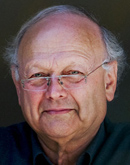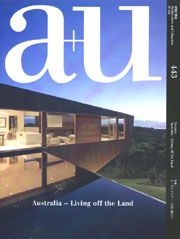

Glenn Murcutt
1936 - born on July 25 in London to Australian parents
1961 - diploma at Sydney Technical College (UNSW)
1964-69 - works for Ancher Mortlock Murray & Woolley, Sydney
1969 - establishes his own office in Sydney
Glenn Murcutt was born to an Australian couple in London in 1936, grew up in New Guinea, and now lives in Sydney, and is by no means a metropolitan person. What made this architect famous are his family homes, located somewhere in the vastness of Australia, far from all cities. The houses, with their corrugated iron roofs, large glass facades, and constructions that resemble more of a temporary tent. Houses like Meager House, Marie Short Funhouse, Riversdale-Houses nestled in the landscape, look like beetles with their flaps and metal wings and could almost scuttle around. These light and nature-friendly homes have made Murcutt one of the most famous Australian architects. Wherever "Australian architecture" is showcased, where there is talk of unity between nature and architecture, Murcutt's retreats are also shown. This represents a double misunderstanding: Murcutt's houses are not any "Australian" architecture, but rather European dreams of simple living transposed into the Australian landscape. "What influenced me the most", says Murcutt, "was the architecture of Mies van der Rohe and Thoreau's famous treatise Walden."
What he builds is a mix of both: romantic solitude in the wilderness, a dream of immediate life far from civilization. Not everything is ecological — in fact, Murcutt's homes come close to the most unecological ideas about building at all (a lonely house outside the city). The idea that led to nature-devouring satellites of family homes on the outskirts of cities, from which columns of cars daily spew forth while simultaneously flattening what they diligently seek: nature. Murcutt is a romantic who has managed to realize his dreams of living in one of the last unspoiled ecosystems on this planet. When he received the Pritzker Prize as its 26th laureate, the jury clearly indicated the following: Not only ecologically advanced buildings for the future of cities, but also romantically conceived structures, show how nature and living can be brought closer together.
One quality of this oddball, who drives a 1979 Citroën and lives on a 700-acre farm, I value above all. As an architect working independently without partners, he has helped establish at least 16 new offices, giving young architects projects he himself did not have time for.
"I showed that as a self-employed architect, I can survive. Not in a wonderfully paid way, but I survived. Young architects saw that they could start their own practice without having to be associated with giant firms for the rest of their lives. The outlook for a young architect to be corporate is not the only path in Australia — there are lots of young people practicing independently or with only one or two others." GM
Realizations and projects
Daphne Murcutt House, Seaforth, Sydney, 1968-72
Glenn Murcutt House, Mosman, Sydney, 1968-69
Glenn Murcutt House, Beauty Point, Sydney, 1968-70
Douglas Murcutt House, Belrose, Sydney, 1969-72
Robertson House, East Killara, Sydney, 1970
Hinder House, Gordon, Sydney, 1970
Lowy House, Mosman, Sydney, 1971
Walker House, Killara, Sydney, 1971
Needham House, Woy Woy, Sydney, 1972
Omega Project House for Ralph Symonds Homes, 1972
Armstrong House, Grenfell, NSW, 1972
Laurie Short House, Terrey Hills, Sydney, NSW, 1972-73
Cullen House, Balmain, Sydney, 1972-74
Luscombe House, Bayview, Sydney, 1973
Wallis House, Manly, Sydney, 1973
Marie Short House, Kempsey, New South Wales, 1974
Hetherton House, Balmain, Sydney, 1974
Jureidini House, Mosman, Sydney, 1975
Meehan House, Kempsey, New South Wales, 1975
Redmond House, Giralang, Canberra, 1975
Stitt House, Longueville, New South Wales, 1976
Done House, Mosman, Sydney, 1976
Ockens House, Cromer, Sydney, 1977-78
Reynolds House, Woollahra, Sydney, 1977-79
Nicholas farm House, Mount Irvine, New South Wales, 1977-80
Berowra Waters Inn, Sydney (phase 1), 1977
Young House, Jindabyne, New South Wales, 1978
Carruthers farmHouse, Mount Irvine, New South Wales, 1978-80
Project House for Devon-Symonds Pty Ltd, North Rocks, New South Wales, 1979
Isherwood House, Mosman, Sydney, 1979
Hornery House, Warrawee, Sydney (cooperation Civil & Civic), 1979
Uther House, Hunters Hill, Sydney, 1980
Murcutt-Robertson House, Kempsey, New South Wales, 1980
Carpenter House, Point Piper, Sydney, 1980-83
Ball-Eastaway House and studio, Glenorie, Sydney, 1980
Maestri House, Blueys Beach, New South Wales, 1981
Museum of Local History and Tourist Office, Kempsey, New South Wales, 1981
Fredericks House, Jamberoo, New South Wales, 1981
New Catholic Presbytery and Community Hall, Mona Vale, Sydney, 1981
Munro House, Bingara, New South Wales, 1981
Rabbit House, Merewether, New South Wales, 1981
Ramsden & Kee House, Blackheath, New South Wales, 1982
Newport House, Hunters Hill, Sydney, 1982
Berowra Waters Inn, Sydney (phase 2), 1982
Magney House, Bingie Bingie, South Coast, Sydney, 1982
Finlay House, Hallidays Point, New South Wales, 1983-84
Littlemore House, Woollahra, Sydney, 1983-86
Pratt House, extension of Raheen, Kew, Melbourne, 1984-94
Herbarium and Visitors Centre, Botanical, 1985
Harrison House, Waverley, Sydney, 1986
Magney House, Paddington, Sydney, 1986-90
Carey House, Springwood, New South Wales, 1987
Museum of Local History, Kempsey, New South Wales, 1987
Offices for Marsh & Freedman, Redfern, Sydney, 1987
Done House, Mosman, Sydney, 1988
Meagher House, Bowral, New South Wales, 1988
Muston House, Seaforth, Sydney, 1988
Marika-Alderton House, Aboriginal Community, Yirrkala, Northern Territory, 1991-94
Preston House, St. Ives, Sydney, 1992
Landscape Interpretation Centre, National Park of Kakadu, Northern Territory, 1992
Murcutt guest studio, Kempsey, New South Wales, 1992
Williams House, Pearl Beach, New South Wales, 1993
Douglas Murcutt House, Woodside, Adelaide, South Australia, 1996
Olsen House, Norton Summit, South Australia, 1996
Ken and Judy Done Gallery, Mosman, Sydney, 1996
Hardeman-McGrath House, Birchgrove, Taylor House, Barrington Tops, NSW, 1996
Schnaxl House, Newport, Sydney, 1995-98
Beckwith/Deakins Terrace House, Paddington, Sydney, 1996-98
Another Aboriginal House, Yirrkala, Northern Territory, 1996-99
'Bowali' Visitors Information Centre, Kakadu National Park, Northern Territory, 1996-99
Arthur & Yvonne Boyd Education Centre, Riversdale, New South Wales, 1996-99
House Bowral, Southern Highlands, NSW, 1997-2001
C. Fletcher & A. Page House, Kangaroo Valley, 1997-2000
Lightning Ridge Community Facility, 1997-
New House, Yorke Peninsula, South Australia, 2002-
New House, Merewether, Newcastle, New South Wales, 2002-
Winery, Lake George, New South Wales, 2002-
Sales Outlet, Winery, Mudgee, New South Wales, 2002-
Eco-Hotel, Great Ocean Road, Victoria, 2002-
New House, Kew, Melbourne, Victoria, 2002-
Extension of 2 houses on Mt. Irvine, New South Wales, 2002-
Extension of the farm in Jamberoo, (realized according to Glenn Murcutt in 1981-82), 2002-














